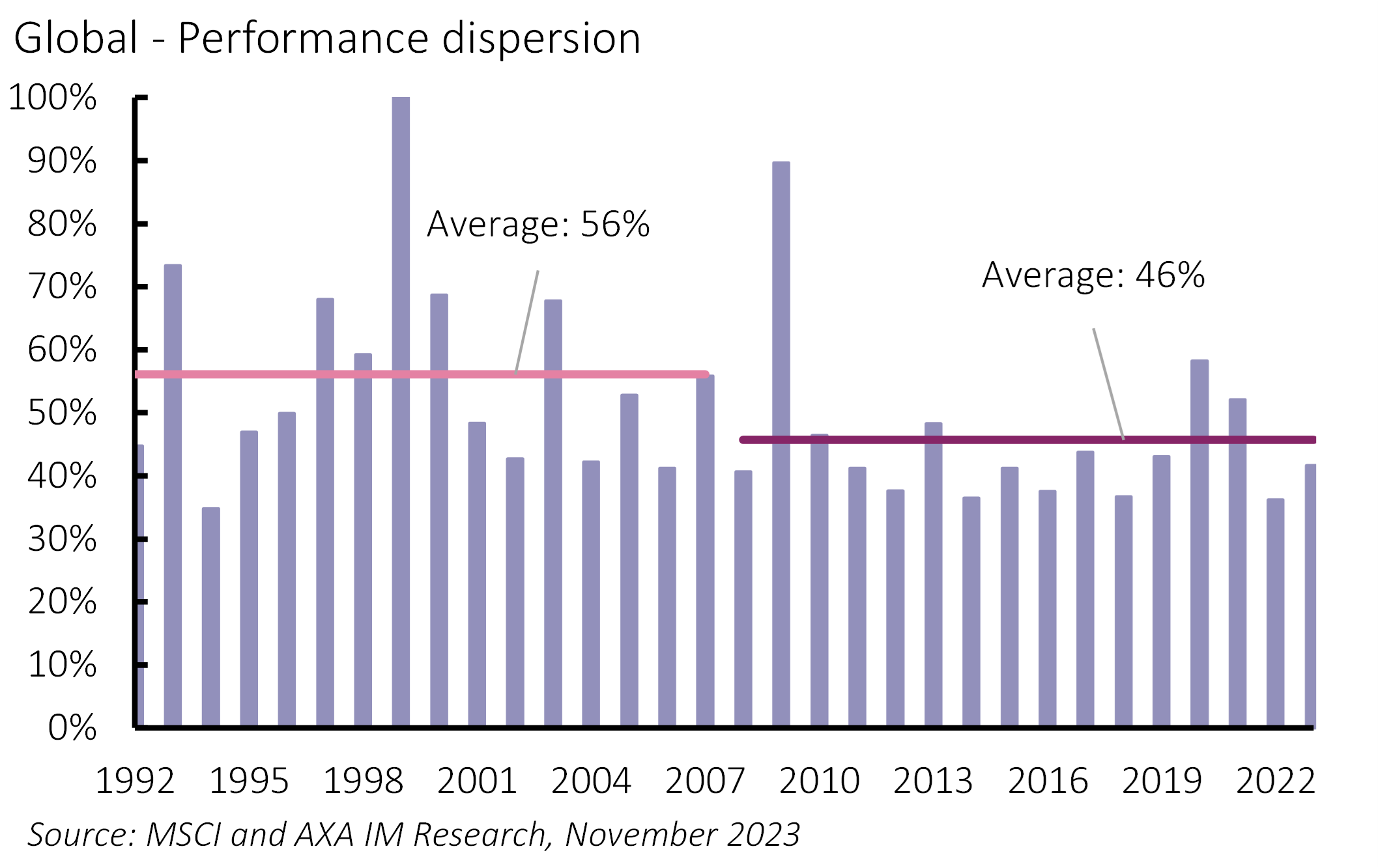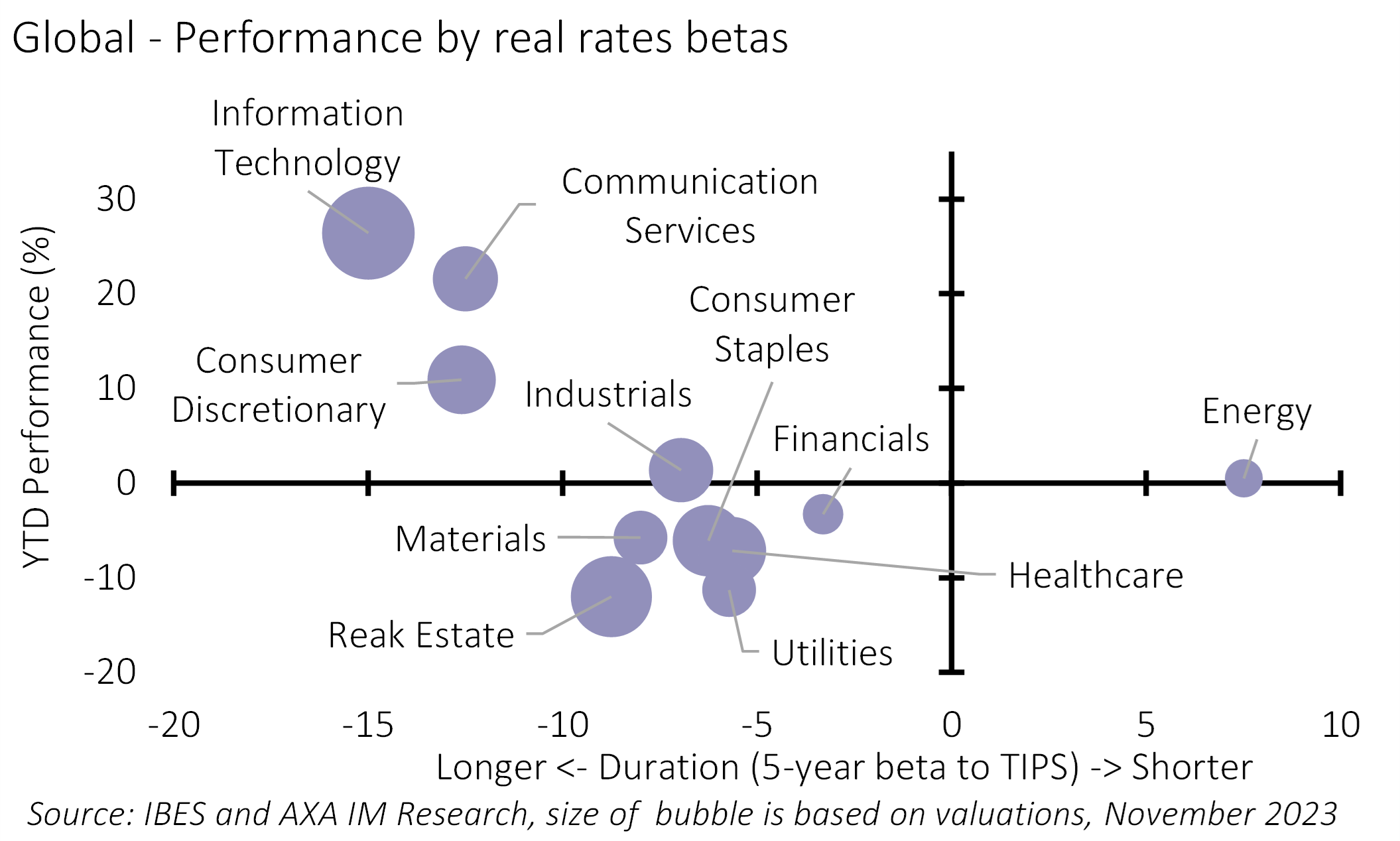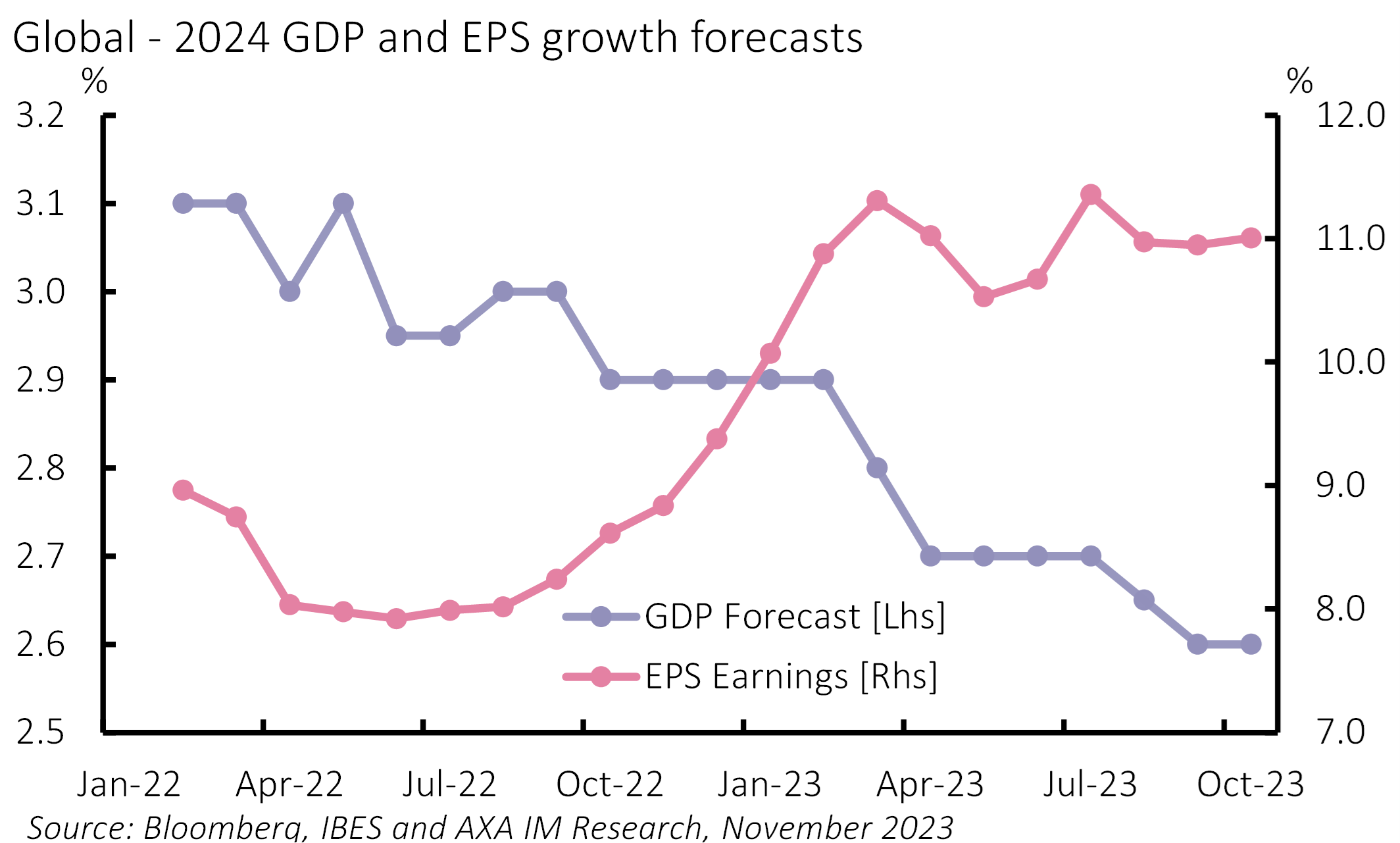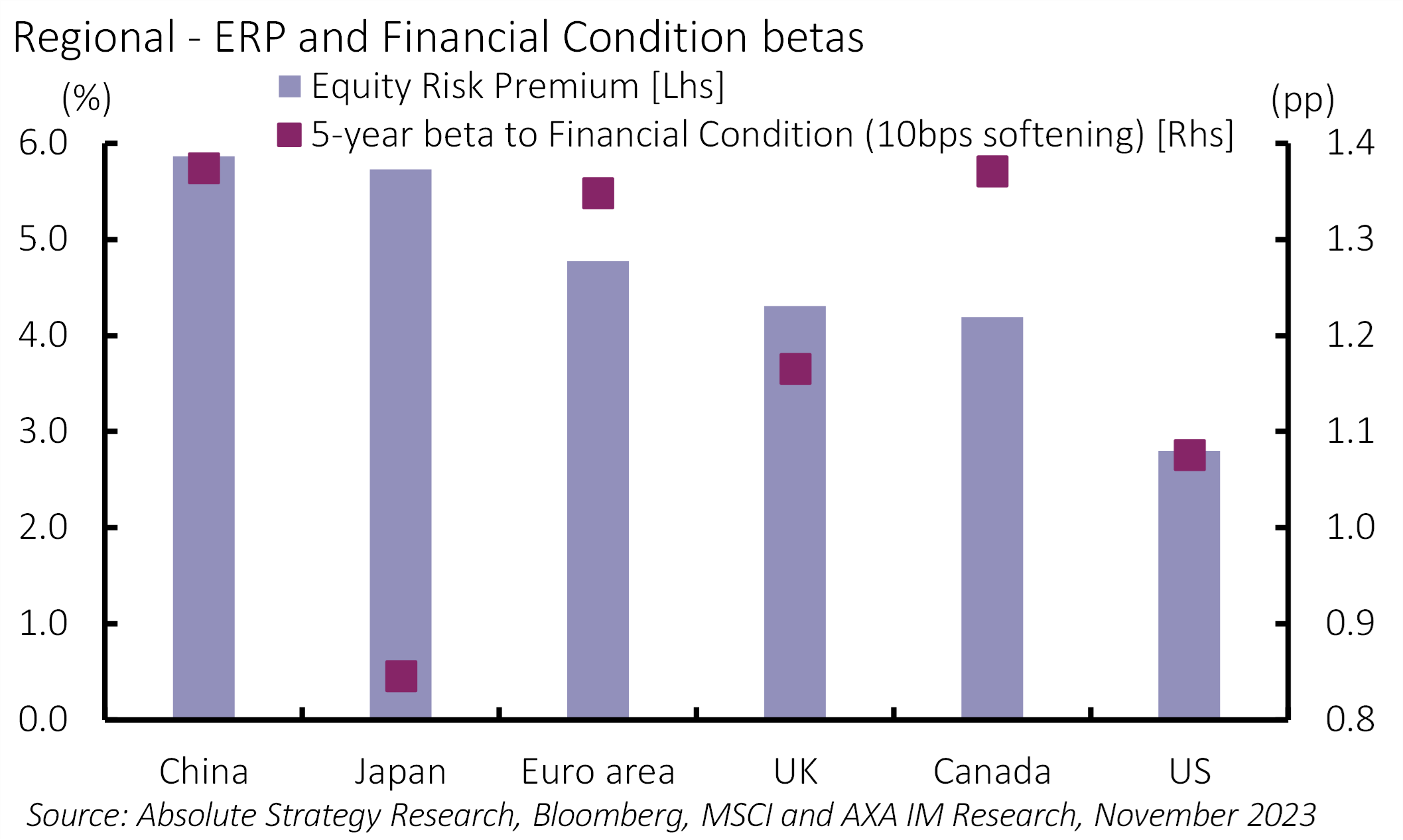
Equity Outlook – Thriving in the mist
Key points
- 2023 was an unusual period for equity markets, which made gains despite sharp interest rates rises. However, only a handful of stocks drove these gains
- As we expect rates to remain high, we believe quality should be considered over the duration of securities
- The question of ‘who’s right’ between GDP and earnings consensus has to be solved, and one of these two projections is likely to be wrong
There is no doubt that 2023 was a year for the textbooks. Low economic growth, high inflation and hawkish central banks were not enough to moderate overall equity market gains. Instead, this trio’s momentum supported the asset class.
But 2023’s performance should be taken with a pinch of salt, as it was largely attributable to a few large-cap stocks. The top 10% of companies ranked by market capitalisation gained 17%, compared with just 3% for the rest. But this divergence in returns between the component stocks of the global index is not abnormal, as evidenced by the below-average level of dispersion (Exhibit 1).
In the future, dispersion could settle higher in the context of higher interest rates. In such a scenario, the equity risk premium would be lower, creating a higher hurdle rate for companies, so active management should overtake passive.
Exhibit 1: Super dispersion

Throughout the course of the year, real global GDP growth expectations have steadily been revised higher, offering support to upward earnings revisions. Although global profits have declined, companies surprised on the upside thanks to the resilience of profit margins.
Interest rate volatility was clearly one of the determining factors of equity market performance. As inflation fell, however, central banks began to halt their tightening cycles. This has been reflected in a performance driven by the multiple expansions in global equity markets, which is at odds with the rise in interest rates.
In our central scenario where growth remains sluggish but a recession is avoided, inflation heads back towards its target and central banks broadly start to reverse course in the second half of the year. We believe that global equities should generate a positive return with some volatility likely reflecting the precise timing of when central banks reverse course.
High for longer
Uncertainties over the short and long ends of US interest rate curves were one of the highlights of the year. These uncertainties were explained for the short end by the constant revision of the expected peak rate until mid-year and then the scale of cuts thereafter, while apparent reassessment of the 'neutral rate' mainly occurring in the second half of the year helped explain higher term rates.
Exhibit 2: Long duration did well despite higher interest rates

There is still uncertainty about the exact timing of the rate cut, but markets are counting on a change towards the end of the first half of 2024 – our own view is for the first cut to be delivered in June 2024. But investors are more convinced rates will stabilise at higher levels for longer, and this convergence of views should mitigate long-term interest rate risks for equities.
Yet the impact of rising interest rates on equities has not been observed in the usual way. Long duration stocks did not fall significantly (Exhibit 2). Instead, those names outperformed the rest of the market and, for instance, value (+2.5%) has underperformed growth (+25.6%).
How do we explain this? The rise in real rates has been uneven – the first half of the year saw real rates remain fairly stable; they then rose by around 80 basis points (bp) from late June. This has been a determining factor in the relative performance of growth versus value (first half: +20.5%, second: +1.8%).
Additionally, it is important to note that, at present, long-duration companies generally have relatively sound balance sheets. Currently, the information technology (IT) sector is the least leveraged, unlike in the past. As a result, equity investors have rewarded these quality stocks regardless of their valuation.
For 2024, we believe the market will continue to favour low-leverage stocks. Also, reaching a new range in long-term rates would suggest less volatility in interest rates, which would improve growth stocks’ forward earnings visibility. This is why a barbell allocation to IT (benefiting from lower rate volatility) and financials (benefiting from structurally higher rates) looks reasonable.
Sluggish growth outlook
At the global level, analysts have consistently and significantly upgraded their 2024 forecasts for earnings growth expecting +11% while consensus GDP forecasts have declined to +2.6% from +3.1% (Exhibit 3). This discrepancy has resulted in an inconsistent relationship between earnings and GDP.
Exhibit 3: The market and macro at odds

The resilience in earnings-per-share has been largely attributed to resilient margins. However, we expect this resilience to fade in 2024, after positive surprises of the results published by companies this year. With pressure from slowing inflation (lower pricing), tight financial conditions and still increasing wage growth, the profit margin could evolve at a below trend pace next year. This suggests a fall in consensus margin expectations of the order of at least 150/300 percentage points for Europe and US market constituents respectively.
Yet this margin contraction alone would not be sufficient to bring earnings growth in line with our 2024 GDP growth forecasts. To achieve this, sales would also require a sizeable downward revision, as the consensus is for +5% in the US and +2.6% in Europe. Such a scenario would push multiples even higher, prompting a greater potential of correction in share prices, although we should not ignore the chance of an upward adjustment in economic growth, as we have seen this year.
If economic growth was to be revised up in 2024, we would prefer exposure to the US than to the rest of the world as historically, upward revisions of US GDP forecasts have been a catalyst for forward US outperformance versus global equities.
To get in on this theme, we think that a long position on US cyclicals, which are currently cheap, would be a judicious move. On a relative basis, we are cautious on emerging markets cyclicals given the uncertainty surrounding the Chinese economic situation.
Exhibit 4: Japan is at the right spot

From a broader perspective, we believe Japan can continue to outperform its peers on a purely macro relative basis. Firstly, we expect Japan to deliver above-trend GDP growth and below-target inflation, which is the best combination for equities. Second, it has the second largest equity risk premium across countries and, finally, we see the lowest market price elasticity to tighter financial conditions (Exhibit 4). Insofar as the study is conducted in local terms, the risk of the yen appreciating could erode the returns for international investors.
This last point is not the least important, since credit defaults, fiscal consolidation and higher minimum rates of return could undoubtedly feed a tighter financial condition trend which should be a clear risk to monitor for the equity market.
Disclaimer
Este documento tiene fines informativos y su contenido no constituye asesoramiento financiero sobre instrumentos financieros de conformidad con la MiFID (Directiva 2014/65 / UE), recomendación, oferta o solicitud para comprar o vender instrumentos financieros o participación en estrategias comerciales por AXA Investment Managers Paris, S.A. o sus filiales.
Las opiniones, estimaciones y previsiones aquí incluidas son el resultado de análisis subjetivos y pueden ser modificados sin previo aviso. No hay garantía de que los pronósticos se materialicen.
La información sobre terceros se proporciona únicamente con fines informativos. Los datos, análisis, previsiones y demás información contenida en este documento se proporcionan sobre la base de la información que conocemos en el momento de su elaboración. Aunque se han tomado todas las precauciones posibles, no se ofrece ninguna garantía (ni AXA Investment Managers Paris, S.A. asume ninguna responsabilidad) en cuanto a la precisión, la fiabilidad presente y futura o la integridad de la información contenida en este documento. La decisión de confiar en la información presentada aquí queda a discreción del destinatario. Antes de invertir, es una buena práctica ponerse en contacto con su asesor de confianza para identificar las soluciones más adecuadas a sus necesidades de inversión. La inversión en cualquier fondo gestionado o distribuido por AXA Investment Managers Paris, S.A. o sus empresas filiales se acepta únicamente si proviene de inversores que cumplan con los requisitos de conformidad con el folleto y documentación legal relacionada.
Usted asume el riesgo de la utilización de la información incluida en este documento. La información incluida en este documento se pone a disposición exclusiva del destinatario para su uso interno, quedando terminantemente prohibida cualquier distribución o reproducción, parcial o completa por cualquier medio de este material sin el consentimiento previo por escrito de AXA Investment Managers Paris, S.A.
La información aquí contenida está dirigida únicamente a clientes profesionales tal como se establece en los artículos 194 y 196 de la Ley 6/2023, de 17 de marzo, de los Mercados de Valores y de los Servicios de Inversión.
Queda prohibida cualquier reproducción, total o parcial, de la información contenida en este documento.
Por AXA Investment Managers Paris, S.A., sociedad de derecho francés con domicilio social en Tour Majunga, 6 place de la Pyramide, 92800 Puteaux, inscrita en el Registro Mercantil de Nanterre con el número 393 051 826. En otras jurisdicciones, el documento es publicado por sociedades filiales y/o sucursales de AXA Investment Managers Paris, S.A. en sus respectivos países.
Este documento ha sido distribuido por AXA Investment Managers Paris, S.A., Sucursal en España, inscrita en el registro de sucursales de sociedades gestoras del EEE de la CNMV con el número 38 y con domicilio en Paseo de la Castellana 93, Planta 6 - 28046 Madrid (Madrid).
© AXA Investment Managers Paris, S.A. 2023. Todos los derechos reservados.
Advertencia sobre riesgos
El valor de las inversiones y las rentas derivadas de ellas pueden disminuir o aumentar y es posible que los inversores no recuperen la cantidad invertida originalmente.